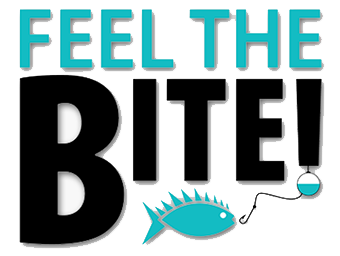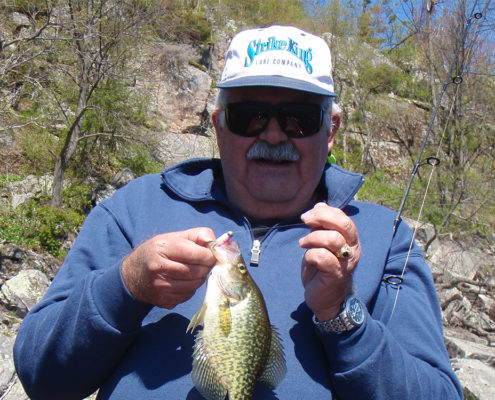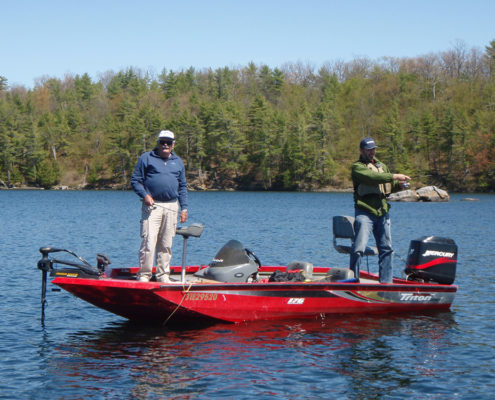Spring Crappy with Art Cunningham
With my buddy Steve Old at the wheel, we set off to join Art Cunningham and his Crappy tournament team-mate, Marv Rolls, for some fishing out of Ceely’s Bay, located at the head of the Rideau River near Kingston Ontario. With multiple crappy tournament wins to their credit – not to mention Art’s three Bass Classic championships, our hosts had plenty of secret Crappy hot-spots and tactics up their collective sleeves. In spite of a cold front that had passed through just two days prior, the weather seemed promising with the exception of high winds that made for some challenging boat handling.
It quickly became evident that Art’s preferred means of finding Crappy is, “run and gun”. They are a schooling fish that prefer weed beds – preferably Coon Tail, or any other form of dark structure in shallower water that will absorb solar energy and at the same time provide cover. Even though the boys new the waters well, it wasn’t until our third location that we encountered our first school. We found in total about five schools that day including one on a rock pile in 6-10 feet of water.
To aid in the search, we fan-casted small 1/8oz jigs with 2.5” grubs in colours white and pink. Art pre-glues his plastics to his jigs which really helps given the sheer number of these fish one can catch in a day. He also feels the larger jigs and trailers (2.5”) work well as Crappy have large mouths and big appetites. Small cranks also do the job, but Art warns that Pike can quickly turn fishing these baits into an expensive proposition. IN the fall he recommends sizing down one’s offerings considerably.
Art’s gear of choice is ultra-light spinning gear with 6lb monofilament line, or in my case a 6lb mono leader on 20lb braded main line. Rods with minimal power and a more parabolic bend are preferred to reduce hook pulls and increase casting range with the lighter baits – not to mention they’re a real joy to use in wrestling these little guys into the boat.
To allow Crappy to properly hook-up and to reduce the instances of hooks being spat, keep your rod at a minimum 45-degree angle to the line during retreaves. Pointing the tip at the bait during retreaves also hampers the detection of light bites due to the tactile telegraphing properties of the rod being bi-passed.
The eyes of a Crappy are positioned at the top of their heads ideal for looking up from their hideaways. They don’t look down or straight ahead for their food. Art says the trick is to allow the jig to free-fall and then reel back slowly so it’s just skimming above the structure.
After ice goes out and the water hits 45 degrees, Crappy become veracious eaters as they prepare to spawn. Art begins his search in Sheltered shallow Bays on the north or east side of lakes and rivers as this is generally where the sun has its most beneficial affect. Areas where creeks or small rivers enter these bays are even better due to the increased water temperatures. This is similar water preferred by Northern Pike in spring so be prepared to get bit off. The omni-danger Pike represent can shut down the Crappy bite in a heart beat.
The capture of other species of fish – especially those still out of season – can be avoided in several ways. Firstly, since Crappy school, there’s no need to move off once you have found the fish. Anchor up and break out the floats. It’s not that float fishing is any more effective at catching Crappy as you’re generally using the same bait and jig, but it’s like Art says, fishing with floats brings out your inner child. Secondly, even when fan casting to seek out these silvery wafes, the type of hook-set one uses can itself cull un-wanted species even before they entre the boat.
The thin paper-like quality of the Crappy’s mouth means these fish pretty much hook themselves on the lighter-wire hooks found on smaller jigs. Art had to remind me on more than one occasion to quit with the hook set as I was simply tearing the hook from their mouths. Not setting the hook also meant that strikes from other bonier mouthed species like Bass or Pike were mitigated by the fish shaking themselves off in short order. I caught in total six different species of fish, but after I toned it down, I reduced my bi-catch considerably.
The winds began to diminish to gusts and eventually fade altogether as the day wore on. Interestingly enough, the frequency of the bite dropped off as well. This may have been due to the sun’s penetration and visibility increasing as the water calmed.
What a great day on the water with well over 150 Crappy caught by all. Turns out spring Crappy is also a fantastic way to re-charge one’s “mojo” for the up-coming season. A big thanks to Art and Marv for their warm hospitality and on-the-water instruction – these gents sure no their craft.







